The last leg of our expedition was to take place back in Nairobi, checking the results of the two week deployment of camera traps and preparing the project for long term functionality following our departure from Kenya.
Following the long drive from Amboseli we were all ready to fall into the inevitable embrace of the hallucinatory dreams induced by our anti-malarials, however, fate had other plans for us that night. To our horror we were to return to Enoch’s home to find the decrepit land rover that had beset us with trouble in Naivasha waiting for us in the drive like a leaking, wheeled spectre. The driver had deposited the car for us under the impression that Enoch was intending on buying it. Given its position blocking the drive we had to move it to park our car, however, the rickety demon of a land rover was to have other plans for us. With a dead battery leaving the spiteful hunk of steel immovable by engine power we were to resort to the man power of the entire CUWCS-CUEX Kenya Expedition 2017. To follow was two hours of pushing and heaving the dusty, creaking land rover back and forth to manoeuvre it out of the conveniently tight-walled driveway in which it had been parked.
Following a much deserved rest we were to awake to the chilly Nairobi air, preparing ourselves throughout the morning to retrieve the data from our camera traps in the field. Following a series of delays it was not until an hour before sun-down that we were able to leave to collect the memory cards from each trap. With a half hour drive to the study site this was to leave us with only half an hour before darkness descended across the Athi Plains. This was to leave us worryingly vulnerable to denizens of the night. With our time limit in mind and with the valiant assistance of Enoch’s son Darwin, our memory card retrieval mission was to proceed as an exercise in efficiency. With the last memory card in hand we were able to take our seats back in the car just as the sun sunk below the horizon and the roars of the local lions began to herald the rise of the moon.
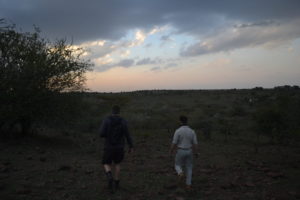
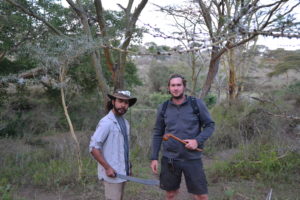
Melodrama aside, the fruits of our labour were worth the high speed hike through the bush. Inspecting the images of the memory cards was to reveal the use of the study area by a plethora of fauna. The exact details of the data collected from the camera traps is so significant for conservation activities in the area that we are unable to share it online due to the potential of its misuse by the wrong people. As such the two week trial had proved to be a huge success, confirming the effectiveness of our project in achieving conservation goals.
A selection of the less sensitive camera trap images:
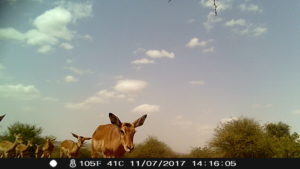

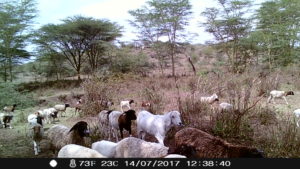
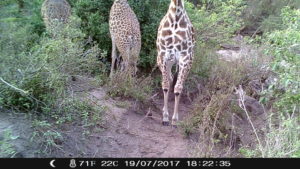
Having analysed the camera trap data our next step was to finalise our long term plan for the project. Upon reviewing the data and following discussion with community leaders and partners we devised a two-year plan of monthly data collection and input into our data table, followed by a seasonal movement of camera traps to allow the whole community area to be sufficiently covered over a yearly period. This data can then be used to inform conservation action and livestock management over the short term. This framework will be reviewed after two years with the aim to use long term data collected to form the basis of an in depth study of movements across park boundaries.
Having arranged to meet with the community chief Nickson on the 24th to re-insert memory cards, move some camera traps to better locations, and deploy yet more traps we were left with a free day on the 23rd. Having run out of expedition-linked activities we paid a visit to one on Nairobi’s more touristy conservation-based attraction, the Nairobi Giraffe Centre. Set up in the 1970s as a breeding centre in response to the population collapse of the Rothschild giraffe (Giraffa rothschildi), the centre breeds these long necked giants, regularly reintroducing individuals into the wild. To provide an income for this exercise and as an opportunity to educate, the centre also offers the opportunity for visitors to come and see and feed their giraffes. The day was spent in a haze of long black giraffe tongues and food pellets, leaving us all thoroughly coated in giraffe saliva.

The next day was to be the final day of the expedition. Awaking early we travelled for the final time to the Athi Kapiti Plains. Meeting with Nickson we spent the day in the area we had come to know so well, hiking through the dusty plains, setting up camera traps and marking locations on the GPS. With all cameras set up we finished our final day of expedition with the customary cup of tea with Nickson.
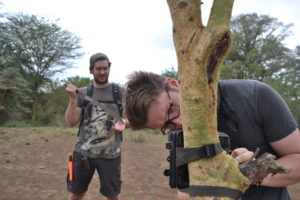
Sitting now, with bag packed, and one final cup of Kenyan tea in hand all that remains are some thank yous. Thanks must go to the Empankasi community, our partners in the camera trap project. Without their willingness to partake in and support conservation in their land we would have no project and the wildlife in their land would have little hope of survival. It is the chief of the Empankasi, Nickson Parmesa, who has been our main partner and contact within the community and it will be him who takes responsibility for the regular checking of camera traps. Without Nickson’s partnership this expedition would never have happened. Of all the Kenyans that have shown us kindness on our expedition it is Enoch and his family that have made us feel most welcome. Enoch’s wife Jemima and son Darwin have been a constant source of warmth and hospitality to us, without them we would have felt far more like strangers in this foreign land, instead we were made to feel like family. Above all thanks must go to Enoch. Acting as translator, guide, driver, colleague and friend, nothing would have happened on this expedition without Enoch’s help. I hope in some small way our work will help to conserve the wildlife and help the people of the beautiful country of Kenya.
Signing off one last time,
Tom Jameson, CUWCS-CUEX Expedition 2017.

